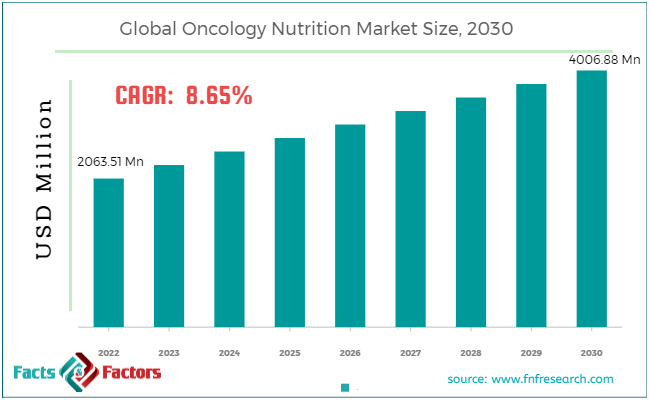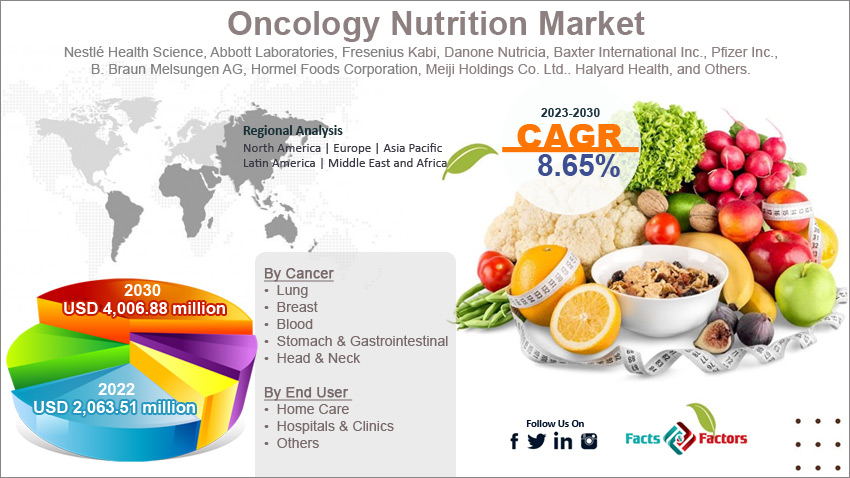Search Market Research Report
Oncology Nutrition Market Size, Share Global Analysis Report, 2023 – 2030

Oncology Nutrition Market Size, Share, Growth Analysis Report By Cancer Type (Lung, Breast, Blood, Stomach & Gastrointestinal, Head & Neck, And Others), By End-User (Home Care, Hospitals & Clinics, And Others), And By Region - Global and Regional Industry Insights, Overview, Comprehensive Analysis, Trends, Statistical Research, Market Intelligence, Historical Data and Forecast 2023 – 2030
Industry Insights
[212+ Pages Report] According to Facts and Factors, the global oncology nutrition market size was valued at USD 2,063.51 million in 2022 and is predicted to surpass USD 4,006.88 million by the end of 2023. The oncology nutrition industry is expected to grow by a CAGR of 8.65%.

 Market Overview
Market Overview
Oncology treatment is a specialized area of nutrition that focuses on the nutritional challenges faced by individuals diagnosed with cancer. Cancer treatments have a profound impact on a person's nutritional status, and therefore, it is important to look at the patient's well-being in terms of proper nutrition. The oncology nutrition focuses on optimizing the nutritional wing of cancer patients before, during, and after the treatment process.
 Key Insights
Key Insights
- As per the analysis shared by our research analyst, the global oncology nutrition market size is estimated to grow annually at a CAGR of around 8.65% over the forecast period (2023-2030).
- In terms of revenue, the global oncology nutrition market size was valued at around USD 2063.51 million in 2022 and is projected to reach USD 4006.88 million by 2030.
- Increasing cancer incidences are driving the growth of the global oncology nutrition market.
- Based on the cancer type, the lung cancer segment is growing at a high rate and is projected to dominate the global market.
- Based on the end user, the hospitals & clinics segment is projected to swipe the largest market share.
- Based on region, North America is expected to dominate the global market during the forecast period.

 Growth Drivers
Growth Drivers
- Increasing cancer incidences are likely to drive the growth of the global market.
The global rise in cancer incidence is contributing heavily to the growth of the global oncology nutrition market. As a result of emerging cancer cases, people are looking for comprehensive cancer care treatment, including specialized nutrition support, to overcome the side effects of radiotherapy, chemotherapy, and other treatments.
Moreover, the aging population is also associated with high cases of cancer all across the globe. Aging individuals pose a huge requirement for nutritional intervention to manage the impact of cancer at an older age.
For instance, Faeth Therapeutics got funding of USD 47 million in a series A round led by S2G ventures. The total money brought up through funding to date is around USD 67 million. The collected money will be invested in the company’s clinical trials for stopping cancer cells from circulating in the body.
 Restraints
Restraints
- Limited awareness among patients is likely to hamper the growth of the global market.
People are still not completely aware of the importance of nutrition support during cancer treatment. This landscape leads to the lack of engagement with oncology nutrition services, and therefore, it is expected to slow down the growth trajectory of the oncology nutrition industry.
 Opportunities
Opportunities
- Patient care and government initiatives are likely to foster huge opportunities in the global market.
The emergence of a patient-centric approach in healthcare has revolutionized the market. Nowadays, people emphasize individual care plans to get treatment according to the patient's needs and preferences, which also includes the oncology nutrition plan.
Also, the increasing government initiatives to enhance and support patient care services, including nutrition support programs, are likely to positively impact the growth of the global oncology nutrition market. For instance, The SmartPN tool was introduced in the market in October 2018 by the American Society for Parenteral and Enteral Nutrition (ASPEN) and Baxter International Inc. to lower the surging rate of clinical malnutrition.
 Challenges
Challenges
- Financial constraints are a big challenge in the global market.
Cancel treatment is quite expensive. Patients face many financial constraints that limit their ability to invest in specialized nutrition products or consultations with expert nutritional oncologists. Therefore, such a landscape is expected to be a big challenge in the oncology nutrition industry.
 Segmentation Analysis
Segmentation Analysis
The global oncology nutrition market can be segmented into cancer type, end user, and region.
By cancer type, the market can be segmented into lung, breast, blood, stomach & gastrointestinal, head & neck, and others. The lung cancer segment is projected to witness huge developments in the oncology nutrition industry. The unique nutritional challenges like difficulty in swallowing, weight loss, loss of appetite, etc., due to lung cancer treatment are boosting the requirement for targeted treatments to address such outcomes. The lung cancer treatments like radiation therapy, chemotherapy, and surgery, pose certain side effects on the nutrition status.
Also, lung cancer is among the most common types of cancer globally. Therefore, such a landscape is propelling the requirement for oncology nutrition. Furthermore, the surging trend of personalized medicine further contributes to the growth of the segment. Personalized nutrition interventions that cater to the specific requirements of lung cancer patients are expected to foster huge developments in the segment.
Also, the collaborative efforts between the healthcare provider and oncology nutrition specialist to contribute to the targeted nutrition strategy for lung cancer patients is another major factor accentuating the market growth in the coming years.
Companies are boosting research and development activities to come up with innovative nutrition interventions to address the unique challenges as a result of lung cancer treatment. Hospitals also hold infusion centers where these patients get nutritional support or intervention nutrition following chemotherapy or other treatments.
By end user, the market can be segmented into home care, hospitals & clinics, and others. The hospitals & clinics segment is expected to swipe the largest share of the global oncology nutrition market. Hospitals and clinics play an important role in offering comprehensive care for cancer patients. Comprehensive care to address the issues not only includes cancer treatment but also the other aspects of patient well-being, including nutrition.
Oncology offers a multidisciplinary approach to address the patient's health. Nutrition support is vital and hospitals are working towards offering well-equipped support to patients. Nowadays, hospitals are offering outpatient and inpatient services to provide nutrition support to cancer patients receiving all kinds of treatments, including radiation therapy, chemotherapy, or surgery.
Moreover, many hospitals have dedicated a clinical nutrition department or a dietician specializing in oncology nutrition. These professionals take care of the nutrition requirements of cancer patients by offering them personalized dietary plans.
 Report Scope
Report Scope
Report Attribute |
Details |
Market Size in 2022 |
USD 2,063.51 Million |
Projected Market Size in 2030 |
USD 4,006.88 Million |
CAGR Growth Rate |
8.65% CAGR |
Base Year |
2022 |
Forecast Years |
2023-2030 |
Key Market Players |
Nestlé Health Science, Abbott Laboratories, Fresenius Kabi, Danone Nutricia, Baxter International Inc., Pfizer Inc., B. Braun Melsungen AG, Hormel Foods Corporation, Meiji Holdings Co. Ltd., Halyard Health, and Others. |
Key Segment |
By Cancer Type, By End User, and Region |
Major Regions Covered |
North America, Europe, Asia Pacific, Latin America, and the Middle East &, Africa |
Purchase Options |
Request customized purchase options to meet your research needs. Explore purchase options |
 Regional Analysis
Regional Analysis
- North America to dominate the global market.
North America holds the largest share of the global oncology nutrition market. The region places a strong emphasis on comprehensive cancer care, including nutritional support. Hospitals and cancer treatment centers in the region view nutrition care plans as an integral part of cancer treatment, which is a primary reason for the high growth rate of the region.
The rising prevalence of cancer in the region also contributes to the large population adopting oncology nutrition services. The region has a well-established healthcare infrastructure to facilitate specialized oncology nutrition services.
Moreover, the research and innovation activities in the field of oncology nutrition are fostering huge developments in the region. The regional institutes and healthcare providers are actively engaging and investing in advanced nutritional care for cancer patients.
Furthermore, the nutritional counseling services in the region are offered by a registered dietician and nutritionist specializing in oncology in the hospitals and clinics. Therefore, people are more interested in getting treatment from hospitals as these professionals work closely with patients and doctors to develop personalized diet plans.
Asia Pacific is also gaining traction in the market because of many reasons. The high prevalence of cancer in the region, along with the growing awareness among people regarding their nutritional support and cancer care treatment, is driving the growth of the global oncology nutrition market. The increasing education regarding cancer prevention, early detection, and supportive care, including nutrition, is also boosting the demand in the region.
Many leading countries in the region are investing in the development of healthcare infrastructure that includes dedicated cancer treatment facilities. Such initiatives are likely to increase patients' accessibility to oncology nutrition services. Therefore, such a landscape is expected to positively impact the growth trajectory of the global market in the forthcoming years.
Additionally, the presence of prominent market leaders in the region is also likely to support the growth path of the market in the region. For instance, Nestle came up with Foods for Special Medical Purpose (FSMP). It is China's first medical meal that is ideal for people suffering from tumor-associated illnesses. The product got approval from the Chinese regulator after five long years.
 Competitive Analysis
Competitive Analysis
The key leaders in the global oncology nutrition market include:
- Nestlé Health Science
- Abbott Laboratories
- Fresenius Kabi
- Danone Nutricia
- Baxter International Inc.
- Pfizer Inc.
- B. Braun Melsungen AG
- Hormel Foods Corporation
- Meiji Holdings Co. Ltd.
- Halyard Health
For instance, Esperer revealed a new nutrition development center in 2020 in Hyderabad. The unit is likely to hold a lot of responsibilities, like product development with a dedicated lab for analyzing sensory taste, packing, components, etc.
The global oncology nutrition market is segmented as follows:
 By Cancer Type Segment Analysis
By Cancer Type Segment Analysis
- Lung
- Breast
- Blood
- Stomach & Gastrointestinal
- Head & Neck
- Others
 By End User Segment Analysis
By End User Segment Analysis
- Home Care
- Hospitals & Clinics
- Others
 By Regional Segment Analysis
By Regional Segment Analysis
- North America
- The U.S.
- Canada
- Mexico
- Europe
- France
- The UK
- Spain
- Germany
- Italy
- Rest of Europe
- Asia Pacific
- China
- Japan
- India
- Australia
- Southeast Asia
- Rest of Asia Pacific
- The Middle East & Africa
- Saudi Arabia
- UAE
- Egypt
- Kuwait
- South Africa
- Rest of the Middle East & Africa
- Latin America
- Brazil
- Argentina
- Rest of Latin America
Industry Major Market Players
- Nestlé Health Science
- Abbott Laboratories
- Fresenius Kabi
- Danone Nutricia
- Baxter International Inc.
- Pfizer Inc.
- B. Braun Melsungen AG
- Hormel Foods Corporation
- Meiji Holdings Co. Ltd.
- Halyard Health
Frequently Asked Questions

Copyright © 2025 - 2026, All Rights Reserved, Facts and Factors


